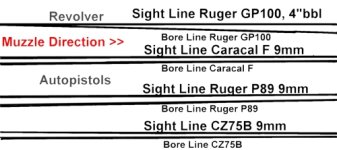So i have a question. The last few months i have been getting into this thing called handguns. Which i am loving! I have fired a few hundred rounds through my 2 357 sp101s. (One 2 inch one 3 inch)
So i am still figuring out my point of aim. At 7 yards it doesnt seam to matter what i shoot it is dead on. 38 or 357. 130 grain or 158. But go back to 15-20 yards things change. With the ammo shortage i dont have much of a chance to "decide" on what to buy, so when deals come up i get whatever i can, which has been a mixed bag. (38 in 110-158 and 357 115-148)
Generally speaking, what will impact where? To me, being an archery man, heavier will impact lower, faster higher, more power higher ect....
I have heard so much and i know each gun will be different. But lets say generally will a 38 lighter go one place, 38 heavier will go another, 357 lighter go one and 357 heavier go one. Which will do what? And more importantly the reason behind why? I know recoil and such will play a roll and just knowing whats in the chamber will play a roll. But does anyone know generally what each will do? Love 38 for practice but will also be woods/trail guns for bears and such and will have 357s in for that so i like practicing for both defense 2 leg and defense 4 leg.
So i am still figuring out my point of aim. At 7 yards it doesnt seam to matter what i shoot it is dead on. 38 or 357. 130 grain or 158. But go back to 15-20 yards things change. With the ammo shortage i dont have much of a chance to "decide" on what to buy, so when deals come up i get whatever i can, which has been a mixed bag. (38 in 110-158 and 357 115-148)
Generally speaking, what will impact where? To me, being an archery man, heavier will impact lower, faster higher, more power higher ect....
I have heard so much and i know each gun will be different. But lets say generally will a 38 lighter go one place, 38 heavier will go another, 357 lighter go one and 357 heavier go one. Which will do what? And more importantly the reason behind why? I know recoil and such will play a roll and just knowing whats in the chamber will play a roll. But does anyone know generally what each will do? Love 38 for practice but will also be woods/trail guns for bears and such and will have 357s in for that so i like practicing for both defense 2 leg and defense 4 leg.



